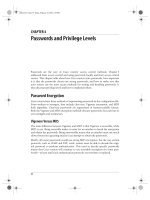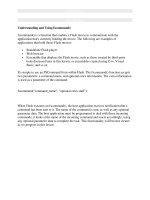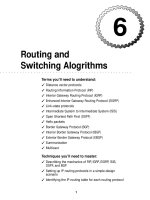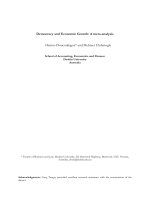Tài liệu INNOVATION AND ECONOMIC GROWTH pdf
Bạn đang xem bản rút gọn của tài liệu. Xem và tải ngay bản đầy đủ của tài liệu tại đây (56.3 KB, 6 trang )
INNOVATION AND ECONOMIC GROWTH
by Nathan Rosenberg
Professor of Economics (Emeritus), Stanford University
Abstract
This paper illustrates why technological innovation is considered as a major force in economic
growth and focuses on some of the most distinctive features of innovation in the highly industrialized
economies of the OECD area. In particular, the paper attempts to examine a primary single feature,
“uncertainty” that dominates the search for new technologies by drawing several cases on the
American experience. It also touches on the impact of technological innovation in the tourism industry
and how it is transforming the tourism business model.
Technological innovation, a major force in economic growth
It is taken as axiomatic that innovative activity has been the single, most important component of
long-term economic growth and this paper will start by drawing upon the findings of a very influential
paper published by my colleague at Stanford, Prof. Abramovitx, back in the mid-1950s.
In the most fundamental sense, there are only two ways of increasing the output of the economy:
(1) you can increase the number of inputs that go into the productive process, or (2) if you are clever,
you can think of new ways in which you can get more output from the same number of inputs. And, if
you are an economist you are bound to be curious to know which of these two ways has been more
important - and how much more important. Essentially what Abramovitz did was to measure the
growth in the output of the American economy between 1870 and 1950. Then he measured the growth
in inputs (of capital and labor) over the same time period. He then made what were thought to be
reasonable assumptions about how much a growth in a unit of labour and how much a growth in a unit
of capital should add to the output of the economy. It turned out that the measured growth of inputs
(i.e., in capital and labor) between 1870 and 1950 could only account for about 15% of the actual
growth in the output of the economy. In a statistical sense, then, there was an unexplained residual of
no less than 85%.
Surprisingly enough, no economist had ever undertaken this exercise before - partly because it
was only after the Second World War that reasonably accurate estimates of inputs and outputs for the
American economy, over some very long time period, became available. Now, in any statistical
exercise in which you are trying to tease out the relative importance of some variable, and you find
yourself with a residual of 85%, you know you are in big trouble! Yet a number of other economists in
the late 1950s and 1960s undertook similar exercises, using different methodologies, different time
periods, and different sectors of the economy, with roughly similar results – they found themselves left
with a very large residual that could not be accounted for. Robert Solow, who later won a Nobel Prize
in Economics, was one of those other economists who discovered a very large residual, using a very
different methodology and different time period. As it happened, he got the same result for the size of
the residual – 85%. It was precisely the size of this residual that persuaded most economists that
© OECD, 2004
1
technological innovation must have been a major force in the growth of output in highly industrialised
economies.
Although it might be tempting to say that the 85% residual was a negative finding, negative
findings can sometimes be extremely useful. In this case the large size of the residual served as a kind
of “wake-up call” to the economics profession because most economists for the previous 200 years
had been building models in which economic growth was treated as if it was primarily a matter of
adding more inputs into the productive process, especially inputs of capital. The large residual told
economists that they had to look elsewhere in order to account for economic growth.
So I am going to focus my attention on some of the most distinctive features of innovative
activity in the world of the highly industrialised economies of the OECD countries, and I will draw, in
several cases, on the American experience. Actually, I want to focus primarily on a single feature that
dominates the search for new or improved technologies, and some of the consequences that flow from
this feature. The key word is “uncertainty.”
Dealing with uncertainties
It is easy to conclude that, in advanced high tech countries, with large, powerful firms,
uncertainties would no longer be a major concern. After all, in the United States today, there are more
than 16 000 firms that currently operate their own industrial research labs, and there are at least 20
firms that have annual R&D budgets in excess of USD 1 billion. In fact, when American
manufacturing firms are ranked by the size of their R&D budgets, the top 20 firms spent a total of
USD 54 billion on R&D in the year 2000. Surely, you might think, such firms are no longer
preoccupied with nagging problems flowing from uncertainties and their attendant financial risks.
Now, if you thought this, you would be wrong, very wrong, and for two compelling reasons. The
first reason, as I have already suggested, is that the conduct of R&D in the high tech sectors of OECD
economies has become hugely expensive. The second reason is that the outcome of this R&D
spending is fraught with financial risks that derive from a variety of sources. What are these sources?
1. Expenditures on scientific research may simply fail to discover new scientific
knowledge of any potential usefulness whatever.
2. Even if new scientific knowledge does emerge from research findings at the
scientific frontier, it may never lead to a new marketable product. Or, equally
important, it may require such a long period of expenditures on new product design
or development that business decision makers may conclude that the realisation of a
new product is likely to be unacceptably costly – i.e. unprofitable.
But even if research does eventually lead to a new, valuable product concept, many further
questions remain to be addressed:
3. How well will the new product perform, not only technologically, but in economic
terms? Will a high performance be attained, but only at a prohibitively high cost?
The Concorde airplane was a simply magnificent achievement in terms of
engineering design and speed, but it was also an unqualified financial disaster. It was
calculated, when the Concorde project was begun, that 300 of the planes would need
to be sold, merely in order to cover its development costs. In the event, only 16 were
sold.
© OECD, 2004
2
4. How rapidly will performance improve and how rapidly is the cost of production
likely to decline?
5. How appropriable is the product for the innovating firm? By “appropriable” I mean,
how great is the likelihood that the innovating firm will be able to capture any profits
that might be generated by its innovation? This may depend on whether the
innovation is patentable. If not patentable, how soon is it likely to be imitated by
competing firms that spent none of their own money in inventing the product? [This
is the “free rider” problem].
6. It is possible that a government regulatory agency, or a court decision, may destroy
expected profits through regulatory requirements or a judicial ruling. In the US
pharmaceutical industry the Food and Drug Administration requires that new
pharmaceutical products go through a protracted period of testing before they may be
sold to the public. Many new pharmaceutical products must be tested for several
years before they can be marketed – in some cases the testing period may be more
than a decade, as in the cases of vaccines or new contraceptive technologies.
Estimates of the cost of bringing a wholly new pharmaceutical product to market in
the US now routinely exceed the USD 500 million Mark.
Additionally, almost everyone in Switzerland must be familiar with ABB’s
devastating financial losses due to its acquisition of an American firm called
Combustion Engineering. It turned out that ABB eventually “inherited” (if that is the
right word) the unexpected liabilities of its subsidiary. These liabilities resulted from
the decision of an American court, in a gigantic class action suit, involving the
potential damage to human health resulting from Combustion Engineering’s
extensive use of asbestos. The class action suit has already involved more than
200 000 claimants, with over 100 000 more claimants still to be dealt with.
7. Finally, how soon will a new and superior product come along, either from a
competitor or from the introduction of some entirely new technology? It is no
paradox to say that one of the greatest uncertainties confronting new technologies is
the invention of still newer technologies.
There is one further source of uncertainty that I feel obliged at least to insert here, even though it
has nothing to do with innovation, and even though you are already painfully familiar with its
consequences to tourism. That is, of course, the possibility of encountering acts of terrorism.
Terrorism has already had a devastating impact on travel, especially travel by air as well as travel to
countries (or areas) where the risks of terrorism are perceived to be high. No other industry is nearly as
vulnerable to terrorism as tourism.
Thus, it is fundamental to an understanding of the nature of innovation to recognise that
uncertainties are still at the heart of innovative activities. The basic fact of life here is that it is
extremely difficult to forecast how the market will respond to the introduction of some new
technology. One obvious reason is that, in societies that have become as affluent as most of the OECD
member countries, it is difficult in the extreme to anticipate how certain new products (or services)
will fit in with consumer preferences and priorities.
© OECD, 2004
3
A few examples of innovation
Let me expand on this point by citing for you an absurdly incorrect failure to anticipate consumer
reactions, on the part of a group of people who were certainly both intelligent and well informed: the
reporters and editorial staff of The New York Times. In 1939 the New York Times reported on the
success of recent experiments that obviously foretold the arrival of a potentially fascinating new
product: television. But the New York Times did not think that television had much of a future – at
least not in the United States. This most prominent and influential of all American newspapers
solemnly declared: “Television will never be a serious competitor for radio, because people must sit
and keep their eyes glued on a screen; the average American family hasn’t time for it.” How do you
explain the complete failure to anticipate that TV was to become the most influential and widely-used
household consumer good of the 20th century? Frankly, I don’t know how to answer that question, but
it has been characteristic of many of the most important innovations of the 20th century that no-one
correctly forecast their future impact. Indeed, far from being unwilling to keep their eyes glued to a
television screen, a disturbingly high percentage of American families seem to have very little time for
anything else!
Suppose we now consider a much more recent innovation: the mobile phone. In 1983, when
AT&T was being divested in an anti-trust suit, it was considering whether it should attempt to retain
the frequencies that would be essential for the operation of mobile phones. AT&T therefore hired one
of America’s best-known consulting firms to forecast the likely number of American subscribers for
mobile phones by the year 1999. The forecast that was eventually given to AT&T was that there might
be as many as one million subscribers to mobile phones in 1999. In fact, the number of subscribers
passed the 70 million mark in that year!
How can you account for what now appears (in retrospect, of course) to have been an absurd
underestimate? Partly, there was a failure to appreciate the very large number of ways in which such
phones would be useful. But the underestimate was also caused by neglect of another consideration
that is widespread in accounting for the future demand for innovations. The fact is that most major
innovations enter the world in a very primitive condition, and go through a long process of technical
improvements and cost reduction. The airplane first left the ground in 1903. The initial flight was less
than the length of a football field, and the airplane was not an innovation of great commercial
significance until the late 1930s. Why not? It took fully one-third of a century because many
thousands of design improvements were necessary before airplanes became sufficiently safe and
reliable to become widely used by the general public. I suspect, if any of us had been present at that
first flight in December 1903, we would not have left the scene with visions of regularly-scheduled
flights crossing the Atlantic Ocean in six hours or so, with passengers in a reasonably comfortable
state.
The situation with respect to the mobile phone in 1983 was, in some important respects, very
similar. Those phones were primitive. They were so heavy and bulky that they hardly deserved to have
been called “mobile.” The quality of voice transmission was extremely poor. And, most important, the
original mobile phones of 1983 sold for around USD 3 000, compared with much less than USD 100
in the United States today.
Consider one other recent technology: the laser. In 1960 the laser was merely a fascinating
scientific breakthrough of no obvious usefulness to anyone. But, as a result of the intense competitive
pressures generated in market economies to develop and introduce new products, the laser came to
serve as the platform for a bewildering variety of new applications. It has become the primary
instrument of research in the science of chemistry. It is the instrument of choice in a wide range of
surgical procedures. There are in fact five medical journals in English that deal exclusively with the
© OECD, 2004
4
use of lasers in medical practice [dermatologists, ophthalmologists, surgeons, etc]. The laser is
essential for the high quality reproduction of music in compact discs (CDs). Transactions at
supermarket checkout counters have been speeded up by lasers that can “read” (i.e. scan) the bar codes
on each item purchased. The best computer printers today make use of the laser. Lasers, together with
optical fibers, have totally revolutionised the worldwide telecommunications system. Last, but surely
not least, the FDA has recently approved the laser as a much less painful substitute for the dentist’s
drill.
The behaviour of lasers had been predicted, on a purely theoretical basis, by Einstein, using no
more than a blackboard and a piece of chalk, as long ago as 1916. But it took over 40 years before
scientists could actually create a laser beam (L
ight Amplification by Stimulated Emission of
R
adiation).
Finally, the computer. The first digital, electronic computer was operating at the University of
Pennsylvania, school of engineering at the end of 1945, and a number of firms were already engaged
in the manufacture and sale of computers by 1950. And yet, as late as 1956 Howard Aiken, a brilliant
physics instructor at Harvard and one of the great pioneers in computer development, continued to
conceive of the computer as no more than a highly specialised scientific instrument. In 1956, in
testifying before a congressional committee he was still, obviously, thinking of the computer as no
more than an instrument suitable for only a narrow range of scientific research purposes. Aiken stated
in that congressional testimony: “ if it should ever turn out that the basic logics of a machine
designed for the numerical solution of differential equations coincide with the logics of a machine
intended to make bills for a department store, I would regard this as the most amazing coincidence that
I have ever encountered.” That is, of course, precisely how it turned out, but it was hardly a
coincidence. A technology that was originally invented for one specific purpose - the numerical
solution of large sets of differential equations - could easily be reprogrammed to solve problems in
entirely different contexts, such as the making out of bills for a department store. But it was obviously
not obvious. Now, nothing could be further from my intention here than to hold Aiken up for ridicule.
Quite the contrary. He was a brilliant scientist and inventor, and yet he hadn’t the most elementary
sense of the potential impact of the invention to which he had made very large contributions.
The impact of a technological innovation
The impact of a technological innovation will generally depend not only on its inventors, but also
on the creativity of the eventual users of the new technology.
Consider the electrification of factories. So long as factories depended on steam as their primary
power source, the organization and layout of activities on the factory floor had to be determined by
proximity to a single power source: the steam engine. Each machine on the factory floor, in turn, drew
upon this power source through a clumsy and extremely wasteful transmission system of leather belts
and pulleys. The introduction of electricity, with separate electric motors attached to each machine,
allowed the layout of work to be organized in a far more flexible and efficient way, depending on the
sequence of activities required by the needs of the production process rather than by the location of the
steam engine. The parallels with the introduction of the computer are obvious. But it is also relevant to
point out that economic historians have recently devoted a great deal of attention to the electrification
of American factories. The consensus of their studies is that it took about 40 years – from the 1880s to
the 1920s – before the application of electric power produced a measurable increase in factory
productivity. And one could also make a plausible argument that the interface between people and
computers is a far more complex one than the interface between people and electric power.
© OECD, 2004
5
© OECD, 2004
6
In thinking about high tech innovation, we tend to be excessively preoccupied with the work of
the scientists and engineers whose R&D activities have created the new technologies in the first place.
This is a case of misplaced emphasis. The benefits that can be made to flow from lasers,
microprocessors, computers and information technology generally, will ultimately depend not only on
its inventors, but also on the creativity of the potential users of the new technology.
Of course, it is also important to remember that the computer itself has been transformed since
the giant mainframes were supplemented (and, to a considerable extent, replaced) by desk-top personal
computers. The result has been an explosion of new efficiency opportunities, insofar as data
processing could now be carried out in ways, and in places, with a degree of flexibility that was not
possible with mainframes alone.
Merely applying much greater computer speed to patterns of work that were designed for an older
and slower technology is likely to yield very little in the way of productivity improvement.
Redesigning the work process is a very complex problem in its own right, and it necessarily takes a
long time, as the early history of electricity amply demonstrates. The introduction of the PC has
required the reorganization of long-standing business practices, along with the design of new, complex
software, tailored specifically for the employees of the business firm. This, in turn, continues to
require the application of managerial skills of a very high order of sophistication in determining how
the patterns of work might be optimally redesigned in order to exploit the vastly expanded capabilities
of the latest generation of computers.
Innovation in tourism
With respect to the tourism sector, what appears to be called for is an intimate familiarity with
consumer needs and preferences in particular specialised markets, and a speedy and imaginative
approach to how these needs might be catered to in a more efficient, but also a more attractive and
more user-friendly manner. But my uninformed speculation suggests that Information Technology,
and the Internet and World Wide Web in particular, are going to transform the role of travel agents,
and doubtless sharply reduce the size of the travel agent industry, unless this industry can identify a
new bundle of services that can be provided to potential travellers. Any household with access to the
Internet – and therefore access to Google – now has immediate access to detailed information about
almost any conceivable location on the earth’s surface as a possible candidate for a visit.
Needless to say, ticketing for airplane travel can also be arranged on the Internet, which also
provides invaluable information about the various prices of airplane tickets. In fact, an American
research company (Forrester) has recently calculated that travel is now the largest on-line business in
the world. The Internet is obviously transforming the tourism business in many ways, and easy access
to information is growing rapidly in each of the separate components of the industry, and making it
increasingly competitive. The ultimate uncertainty is figuring out new ways of rendering the tourist
industry at least minimally profitable. I am happy to leave this subject to your deliberations over the
next two days.









